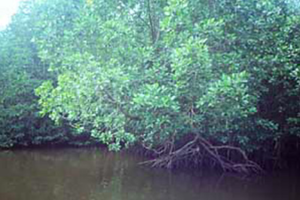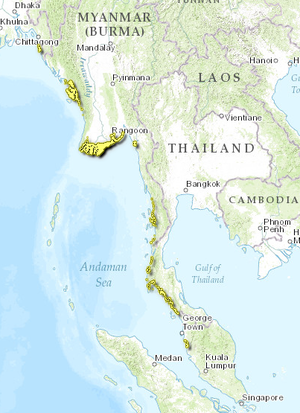Myanmar Coast mangroves

Introduction
The Myanmar Coastal (Myanmar Coast mangroves) Mangroves are some of the most degraded or destroyed mangrove systems in the Indo-Pacific. The sedimentation rate of the Irrawaddy River is the fifth highest in the world. This is largely because of the deforestation that has occurred throughout central Myanmar. The mangroves have also been overexploited from forestry, agriculture, aquaculture, and development projects. The wild species have been severely reduced but hang on in isolated pockets.
Location and General Description
Myanmar Coastal Mangroves ecoregion is found in the Irrawaddy delta. The mouth of the Irrawaddy River was some 170 miles inland near Prome 300,000 years ago. On the islands of Twante, Myaungmya, and Bassein, lateritic ridges stood above the water. The delta is composed largely of alluvium, and a large area is occupied by volcanic rocks.
The mangrove flora consists of three separate regions: the Rakhine mangroves, Irrawaddy mangroves, and Taninthayi mangroves. The Rakhine mangroves are made up primarily of Rhizophora mucronata, R. candelria, Sonneratia spp., Kandelia rheedeii, Bruguiera spp., Xylocarpus granatum, X. moluccensis, Nipa fruticans, and Phoenix paludosa. The Irrawaddy mangroves consist of Rhizophora mucronata, R. conjugata, Bruguiera parviflora, B. gymnorhiza, B. cylindrica, Heritiera formes, Sonneratia apetala, S. griffithii, S. caseolaris, Xylocarpus granatum, X. molluccensis, Ceiops roxburghiana, C. mimosoides, Avicennia officinalis, Kanddelia rheedii, and Excoecaria agallocha. Finally, the Taninthayi mangroves contain Rhizophora spp., Sonneratia caseolaris, Ceriops tegal, Xyloxarpus granatum, Avicennia officinalis, and Bruguiera spp.
Biodiversity Features
Several mammal species occur in this ecoregion but in small and scattered populations. Wild elephants (Elephas maximus) are represented by a small population of approximately 150 animals. Rakhine is one of the last regions where Asian elephants still roam wild. During the dry summer elephants come down from the mountains to the mangroves to drink salt water. The population estimate for Rakhine State in 1990-1991 was between 750 and 1,100, with the country total between 4,115 and 4,639.
The tiger used to be plentiful all over the country some forty years ago but has been persecuted to the point of extirpation. There are at most 150 tigers remaining in Myanmar, and it is unknown how many, if any, use the dwindling mangroves. Tiger (Panthera tigris), leopard (Panthera pardus), wild dog (Cuon apinus), and otter (Lutra spp.) were reported in 1982 but probably have been extirpated or survive only in low numbers. As a result, sambar (Cervus unicolor), hog deer (Cervus porcinus), mouse deer (Tragulus javanicus), barking deer (Muntiacus muntjak), tapir (Tapirus malayanus), and wild boar (Sus scrofa), prey species for many predators, are abundant in the reserved forests.
Bird life in the mangroves is rich in migrants and resident waterbirds. A few resident waterbirds include the oriental darter (Anhinga melanogaster), little cormorant (Phalacrocorax nigers), reef heron (Egretta sacra), dusky gray heron (Ardea sumatrana), ruddy shelduck (Tadorna ferruginea), bronze-winged jacana (Metopidius indicus), lesser sand plover (Charadrius mongolus), great stone plover (Esacus magnirostris), black-winged stilt (Himantopus himantopus), spotted greenshank (Tringa guttifer), lesser black-back gull (Larus fuscus), and common moorhen (Gallinula chloropus). One of the most highly threatened residents is the edible-nest swiftlet (Collocalia fuciphaga), found inhabiting rocky limestone caves. The nests, which are an expensive delicacy, are highly valued and collected.
The southern part of the delta contains the last population of crocodiles (Crocodylus porosus) in the ecoregion. The river terrapin (Batagur baska) has also been reduced to a few small populations on offshore islands as a result of egg overcollection.
Current Status
Mangrove forests are subject to severe degradation because there is no clear-cut land-use system. Forestlands have been converted to agriculture and other development activities, not only in this ecoregion but throughout Myanmar. Irrawaddy is one of the most heavily silted [[river]s] in the world. The sedimentation rate was 299 million tons per year, and it ranked fifth behind the Yellow, Ganges, Amazon, and Mississippi rivers in silt deposition. Today the sedimentation rate in getting worse as deforestation (Land-use and land-cover change) and agricultural erosion continue. If the situation between 1977 and 1986 is maintained, it is estimated that all the mangrove forests will disappear in fifty years.
A new Forest Policy, Forest Act, and Wildlife Protection Act are in force today. However, implementation of conservation and protection activities is poor, with a shortage of staff to police and monitor the few protected areas proposed (Table 1). This is primarily because of an inadequate budget.
|
Table 1. Protected Areas That Overlap with the Ecoregion. | ||
|
|
|
|
|
Letkokkon |
4 |
PRO |
|
Meinmahla Kyun |
120 |
PRO |
|
Kadonlay Kyun |
1 |
PRO |
|
Total |
125 |
|
Types and Severity of Threats
The entire ecoregion is under severe threat of conversion and illegal settlements. Rice yields decline on reclaimed mangroves within a few years, and new areas are cut. Fertilizer on reclaimed mangroves causes more harm than good because of the accumulation of acid sulfate over time. Mangroves are being intensively cut for firewood, charcoal burning, and nontimber produce. Mangroves are increasingly converted to fish and prawn aquaculture to meet the demand of an increasing population.
Wildlife poaching is rampant. Wild elephant, tiger, sun bear, monkey species, wild boar, banteng, and sambar are being intensively hunted. Tigers are often killed for the bones and skins for sale to wildlife traders in Thailand and China. There is no control over the extraction of forest resources despite forest reserves having legal protected status. Illegal logging is more prevalent than legal logging concessions.
Additional Information on this Ecoregion
- For a shorter summary of this entry, see the WWF WildWorld profile of this ecoregion.
- To see the species that live in this ecoregion, including images and threat levels, see the WWF Wildfinder description of this ecoregion.
| Disclaimer: This article is taken wholly from, or contains information that was originally published by, the World Wildlife Fund. Topic editors and authors for the Encyclopedia of Earth may have edited its content or added new information. The use of information from the World Wildlife Fund should not be construed as support for or endorsement by that organization for any new information added by EoE personnel, or for any editing of the original content. |
